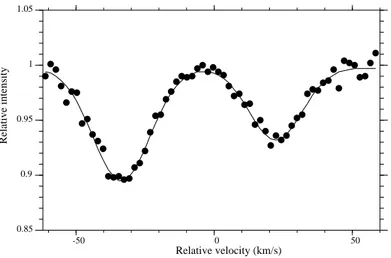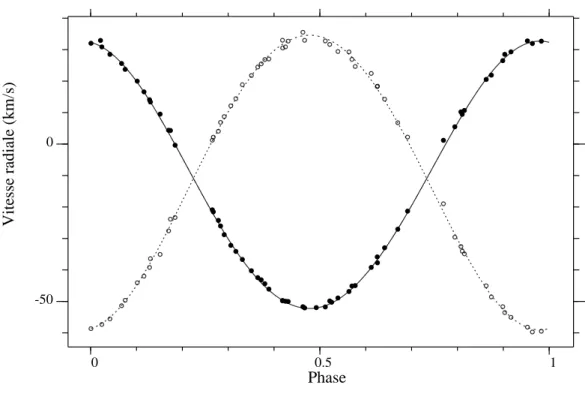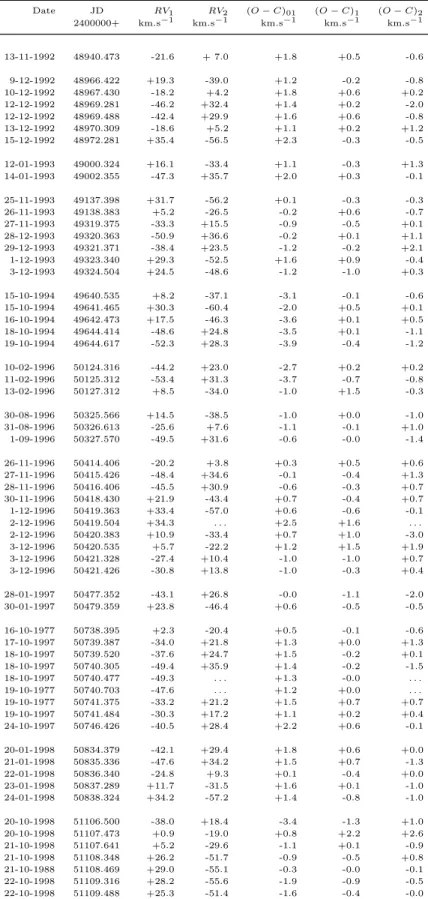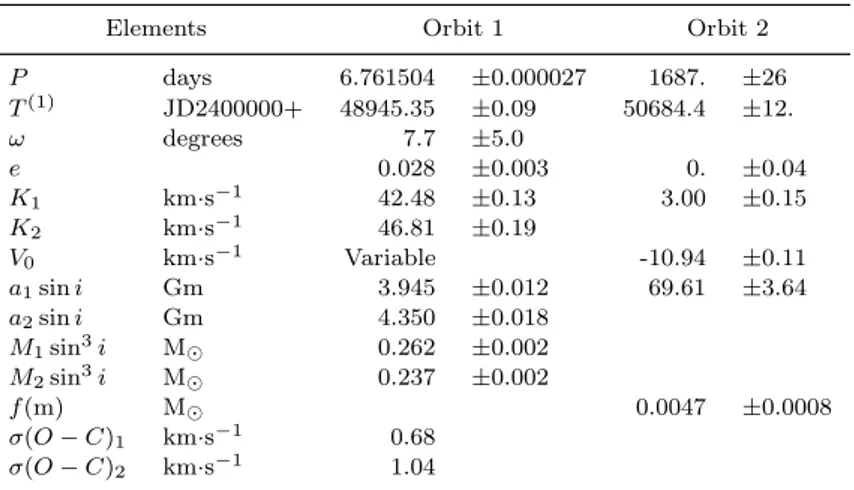HAL Id: hal-02455263
https://hal.archives-ouvertes.fr/hal-02455263
Submitted on 25 Jan 2020
HAL is a multi-disciplinary open access
archive for the deposit and dissemination of sci-entific research documents, whether they are pub-lished or not. The documents may come from teaching and research institutions in France or abroad, or from public or private research centers.
L’archive ouverte pluridisciplinaire HAL, est destinée au dépôt et à la diffusion de documents scientifiques de niveau recherche, publiés ou non, émanant des établissements d’enseignement et de recherche français ou étrangers, des laboratoires publics ou privés.
III. HD 7119, a double-lined spectroscopic binary and a
triple system
Jean-Michel Carquillat, Nicole Ginestet, Jean-Louis Prieur, S. Udry
To cite this version:
Jean-Michel Carquillat, Nicole Ginestet, Jean-Louis Prieur, S. Udry. Contribution to the search for binaries among Am stars. III. HD 7119, a double-lined spectroscopic binary and a triple system. Monthly Notices of the Royal Astronomical Society, Oxford University Press (OUP): Policy P - Oxford Open Option A, 2002, 336, pp.1043-1048. �hal-02455263�
Contribution to the search of binaries among Am
stars. III. HD 7119: a double-lined spectroscopic
binary and a triple system. ⋆
J.-M. Carquillat,
1N. Ginestet,
1J.-L. Prieur,
1and S. Udry
21UMR 5572 d’Astrophysique, Observatoire Midi-Pyr´en´ees – CNRS, 14, Avenue Edouard Belin, 31400 Toulouse, France. 2Observatoire de Gen`eve, 51, Chemin des Maillettes, CH-1290 Sauverny, Suisse.
Received July 8th 2002; accepted
ABSTRACT
Radial velocity observations of HD 7119 with the CORAVEL instrument at Observatoire de Haute-Provence are reported. Known as an Am/δ Del metallic-line star, HD 7119 was included in our spectroscopic survey of Am-type stars whose purpose was to determine the frequency of binaries in this stellar family. This object is found to be a double-lined spectroscopic binary
with a variable value of V0, the systematic velocity of the center of gravity
of the pair. The variation of this parameter is interpreted in terms of orbital motion of an unseen third body with a much longer period. The orbital ele-ments were derived for both the short and the long period orbits. These orbits can be considered as well determined since these observations were performed on a regular basis over the 1992-1998 period, covering more than 320 orbital cycles for the short-period (P=6.76 days) and 1.3 cycle for the long-period orbit (P∼1700 days). As deduced from the ratio of the correlation dip ar-eas, the magnitude difference of the components of the short-period system is 0.7 mag. Combined with the Hipparcos data, this value leads to visual ab-solute magnitudes of 0.5 and 1.2 for the primary and secondary components respectively. Such magnitudes are consistent with evolved δ Del-type stars.
The third body could be a cool dwarf star with a minimum mass of 0.5 M⊙,
located at ∼0.016′′of the main system. Consequently, it cannot be the visual
component was a physical component, (not an optical one), HD 7119 would be a quadruple system.
Key words: Stars: individual: HD 7119 - Binaries: spectroscopic - Stars:
fundamental parameters
1 INTRODUCTION
We present a study of the radial velocity of HD 7119 (HIP 5588) based on spectroscopic observations performed in 1992-1998 with the CORAVEL instrument (Baranne et al. 1979). This instrument was mounted at the Cassegrain focus of the Swiss one-meter telescope of Observatoire de Haute-Provence (OHP).
This work belongs to an extensive program to study the frequency of binaries among the family of hot stars with metallic lines of Am-type. Started in the early 1990’s, this program concerns a large sample of Am-type stars mainly from the “Third catalogue of Am stars with known spectral types” (Hauck 1986). The full description of this sample and the first results are presented in Ginestet & Carquillat (1998, Paper I) and North et al. (1998). In his catalogue, Hauck selected Bertaud (1970)’s classification for HD 7119, i.e., A5 for the CaII K-line, and F2 for the metallic lines (nothing was mentioned about the hydrogen lines). HD 7119 was first reported as Am by Bidelman (1964) from objective-prism observations, and then re-classified as δ Del by A.P. and C.R. Cowley (1965), using Morgan’s classification spectrograph. In a more recent paper, Bossi et al. (1983) reported a private communication where M. Jaschek confirmed Cowley’s δ Del classification. More recently still, a new classifi-cation was established with the Marly spectrograph at OHP (IIaO plates with a dispersion of 80 ˚A.mm−1) by Grenier et al. (1999), who gives: Am (A4 A8 F4). This last classification
is close to Bertaud’s. However, Grenier et al. note that the absolute magnitude of HD 7119 derived from the Hipparcos parallax leads to a much too large luminosity compared to the proposed spectral type. This apparent discrepancy vanishes when considering the δ Del type previously attributed to this object.
Bossi et al. have detected a possible photometric variability of HD 7119 in the visible domain, which may be due to pulsations. For these authors, evolved stars with metallic lines of δ Del type could also be pulsating variables, whereas this seems to be out of the question for dwarf stars of Am-type.
In the present work, we reveal the (to our knowledge, previously unknown) double-lined spectroscopic binary nature of HD 7119. Previous spectroscopic observations, also performed at OHP (Fehrenbach et al., 1997, Grenier et al., 1999), did not reveal the binary nature of this object. This lack of detection is probably the consequence of an insufficient spectroscopic dispersion (80 ˚A/mm in both cases, which limits the resolution at ∼110 km/s). We find that the short-period system, with a period close to seven days, exhibits a variation of the velocity V0 of its center of gravity with a period of 4.7 years. As HD 7119 is also known as a visual
binary (Cou 147 AB, Couteau, 1978) we investigate whether the third “spectroscopic” body corresponds to the visual component detected by Couteau at Nice Observatory.
2 OBSERVATIONS AND DERIVATION OF ORBITAL ELEMENTS
Sixty radial velocity (RV ) measurements were performed with CORAVEL and were used for the determination of the orbital elements of the system. These observations (Table 1) were obtained over six years (November 1992 – October 1998) which correspond to 320 orbital cycles. CORAVEL is a spectrophotometer which allows radial velocities measurements by performing a cross-correlation of the stellar spectrum with a physical mask placed in the focal plane of the spectrograph (Baranne et al., 1979). Gaussian functions are then fitted to the cross-correlation dips to derive radial velocities. Fig. 1 shows an example of the correlation dips observed for the primary and secondary components of HD 7119. Given the width of these dips, the minimum RV separation of two components is ∼20 km/s. Five measurements had to be discarded because the correlation dips were blended. The mean internal error is 0.7 km.s−1 for the primary RV and 0.9 km.s−1 for the secondary RV .
The orbital elements were first computed with the least-square program BS1 (Nadal et al., 1979), revised by J.-L. Prieur. During a first test on the primary RV , it appeared that most residuals (O − C)01 were too large, and not randomly distributed (Col. 5 of Table 1 and
Fig. 2). Their standard deviation was σ(O − C)01 = 1.7 km.s−1, which was more than twice
the mean error of the RV measurements. The presence of a perturbing third body, with a much larger period was thus very likely.
A new program (BS3) was then developed by J.-L. Prieur to simultaneously fit the orbit of the two visible components and that of the invisible third component. To obtain the initial values of the orbital parameters for the long-period system, we proceeded with the same method as for HD 83270-1 (Ginestet et al., 1991). We split the 60 RV measurements into
-50 0 50 0.85 0.9 0.95 1 1.05 Relative velocity (km/s) Relative intensity
Figure 1.Typical CORAVEL cross-correlation dip obtained for HD 7119.
4.9e+04 5e+04 5.1e+04
-5 0
Date (Jul. Day)
Residuals (km/s)
4.9e+04 5e+04 5.1e+04
-2 0 2
Date (Jul. Day)
Residuals (km/s)
12 small ”observation groups” (separated by blank lines in Table 1) for which the variation of the velocity V0 of the center of gravity of the short-period system could be neglected.
The variation versus time of the residuals obtained in these groups could be interpreted as a Keplerian motion due to the presence of a third body. We obtained a first estimation of the elements of the long-period orbit by applying the least-square program BS1 to these residuals.
These values were then used as initial values by the least-square program BS3 which simulta-neously fitted the two orbits. For that computation, weights of 1.0 and 0.5 were respectively used for the primary and secondary RV measurements. The residuals obtained in that case (Table 2 and Fig. 2) are very close to the mean standard deviation of the measurement errors for both components and do not exhibit any long-term variation. The two orbits are displayed in Figs. 3 and 4 and the corresponding elements with their errors are given in Table 2.
The eccentricity of the two visible components is very small and the orbit is nearly circu-lar, which is not surprising, given the short period of 6.76 days. This small value for the eccentricity is nevertheless significant with regards to its error value. The presence of a third body may have contributed to the small eccentricity in a system already circularized (Mazeh 1990).
The orbit of the third body was first assumed as circular, on the basis of the distribution of the residuals (Fig. 4). When adding two more parameters (eccentricity and omega for the long-period orbit) to the model, the residuals remained at the same level and the eccentricity derived was very small, equal to zero within the errors.
3 DISCUSSION
3.1 Physical parameters of the short-period system
The ratio of the correlation dip areas given by CORAVEL for the primary and secondary components allows an evaluation of the magnitude difference (Lucke & Mayor 1980). For HD 7119, this ratio is 1.93, which leads to ∆mV = 0.715, if we assume that the two stars
have similar temperatures.
The mass luminosity relation for main sequence stars with Mbol < 7.5, as given by
Schmidt-Kaler (1982), is: logM/M⊙= 0.46−0.10Mbol, i.e., in the case of a binary system: logM1/M2 =
compo-nents are similar and thus ∆MV ≈ ∆Mbol. The mass ratio is directly derived from
or-bital data with M1/M2 = K2/K1. From Table 2 we obtain M1/M2 = 1.102 ± 0.003 and
∆MV = 0.42 ± 0.03 mag., which is smaller than the value derived from the correlation dips.
This is an indication that the two stars are not at the same evolution stage. In particular, the primary is more luminous than a dwarf star with a similar mass.
In the Hipparcos catalogue (ESA, 1997), we find the following values: V = 7.57, B−V = 0.34, π = 3.38 ± 0.93 mas. HD 7119 would then be at a distance d = 300 (+110, -70) pc. Its global absolute magnitude would be MV = 0.035 ± 0.60, assuming an interstellar absorption of
0.18 mag. (Lucke 1978). If we neglect the contribution of the invisible third body, this would lead to: MV1 = 0.50 ± 0.60 and MV2 = 1.20 ± 0.60 for the absolute magnitudes of the
primary and the secondary, respectively. If both stars are hot late stars with metallic lines, which is very likely when considering the global index B − V , these values correspond to the magnitudes of giant stars (Schmidt-Kaler 1982). The two visible components are then two δ Del stars.
Obviously, the lack of knowledge of the orbital inclination i forbids a direct determination of the component masses. To estimate these values, we can use Schaller et al. (1992)’s theoreti-cal HR diagram with evolution tracks, and the isochrones given by Meynet et al (1993), as in Carquillat et al. (2001) for the system HD 98880. For HD 7119, we estimated Teff ≈7500 K,
on the basis of a de-reddened colour index B − V =0.28, and the luminosity of each com-ponent by applying a bolometric correction of −0.1, to the absolute magnitudes previously found. Taking into account the uncertainties on these values, the two stars were plotted on the same isochrone with the constraint of a mass ratio equal to K2/K1 = 1.10, as observed.
The corresponding mass values are M1 = 2.2 ± 0.3M⊙ and M2 = 2.0 ± 0.3M⊙, with an age
of ∼8. 108 years.
The radii can be estimated using the well-known relation log R/R⊙ = 0.5 log L/L⊙−2 log T +
7.54 with log L = 1.9 − 0.4Mbol. This leads to R1 = 4.6+1.4−1.1R⊙ and R2 = 3.3+1.1−0.8R⊙. If we
are dealing with late Am-type stars, as proposed in this section, these radii are compatible with those of evolved stars (Schmidt-Kaler 1982).
The value of M1sin3i found in Table 2 then leads to i = 29.5 ± 2.0◦, and to a separation
of the components of a = a1+ a2 = 17.0 ± 1.0 Gm, i.e., 24.0 ±1.5R⊙. Given the estimated
3.2 Rotation-revolution synchronism
When considering the short period of the main couple, one may expect that their rotation is synchronized with their orbital motion. In order to check this hypothesis, we applied the Kitamura & Kondo (1978) test on each component. This test assumes that synchronism indeed is verified and then estimates the value of the component radius corresponding to the observed rotation velocity and orbital period (i.e., R/R⊙ = Ve×P/50.6, where Ve is the
equatorial rotation velocity in km.s−1 and P the orbital period in days). When the values
found for each component are compatible with typical radii of stars with similar spectral types, it is likely that there is indeed synchronism. Let us note that this test assumes that the orbital and equatorial planes of both stars are co-planar. This assumption is needed since the rotation velocity is only measured via the projected velocity v sin i.
As shown by Benz & Mayor (1981, 1984), the projected velocity can be derived from the analysis of the CORAVEL correlation dips. For HD 7119, the values of v sin i for the primary and secondary are respectively 12.8 ± 0.2 km.s−1 and 7.8 ± 0.4 km.s−1. With the
assump-tions already mentioned (synchronism and co-planarity) these values lead to radii of 3.5 R⊙
and 2.1 R⊙ for the primary and secondary respectively. These values are smaller than the
estimated values from the physical parameters (cf. Sect. 3.1), but they are still in reason-able agreement, given the rather large uncertainties. For instance a small deviation from coplanarity with an inclination of the rotation axes of i = 22◦ (instead of i = 29◦ for the
orbital axes) would lead to R1 = 4.5 R⊙ and R2 = 2.8 R⊙, in very good agreement with the
theoretical values. We thus conclude that synchronism is plausible for both components.
3.3 Hypotheses on the third body
Let f (m) = (M1+ M2) sin3i g(µ) be the mass function of the long-period orbit (orbit 2 of
Table 2), with µ = M3/(M1+ M2), g(µ) = µ3/(1 + µ)2, where M3 is the mass of the third
body.
With the values found in Sect. 3.1, the total mass of the short-period system is M1+ M2 =
4.2 M⊙. As the mass function is f (m) = 0.0047 M⊙ (Table 2), the mass ratio is µ ≥ 0.11,
i.e., M3 ≥0.47 M⊙. This boundary value (assuming i = 90◦ for orbit 2) corresponds to the
mass of a cool dwarf with a spectrum close to M2 (Schmidt-Kaler 1982). As an alternative, if we assume that the orbital plane of the short-period couple and that of the third body are co-planar (i ∼ 30◦
body could be a dwarf star of solar type, and would also be invisible because of a too large brightness difference (∆mV ∼5 mag.).
Using the value a1sin i = 69.61 Gm for the long-period orbit (Table 2), the separation a′ of
the third body may thus be approximated by: a′ ≈
a1sin i(1 + 1/µ)/ sin i. For i = 90◦ and
i = 30◦, we obtain a′ = 702 Gm (4.7 AU) and a′ = 724 Gm (4.8 AU) respectively. At the
expected distance of 300 pc, this corresponds to an angular separation of 0.016′′.
In the introduction, we mentioned that HD 7119 was known as a visual binary (Cou 147), since Couteau’s discovery in 1967 with the 50 cm refractor of Nice Observatory (Couteau 1968). The visual companion was recently confirmed by a new observation in 1992 by Thorel (1996). Although the magnitude difference of ∼ 5 mag. reported by Thorel is close to that of the third “spectroscopic” body that we found, the separation of 3.35′′ of the visual
companion is considerably larger than the estimation we have just done (0.015′′
). Note that the visual companion could also be an optical one, since the position parameters (θ, ρ) did not significantly change between the two observations of 1967 and 1992. On the other hand, if the visual companion really is a physical companion, HD 7119 is a quadruple system.
Acknowledgments: We are indebted to Michel Mayor, Director of Geneva Observatory, for giving us observing time with CORAVEL. For bibliographic references, this work made use of the SIMBAD database, operated by the “Centre de Donn´ees Astronomiques de Strasbourg” (France). We thank Emmanuel Davoust for kindly correcting the English spelling of this manuscript. Finally, we acknowledge the anonymous referee for his constructive comments and suggestions.
REFERENCES
Baranne A., Mayor M., & Poncet J.L., 1979, Vistas Astron. 23, 279 Benz W., Mayor M., 1981, A&A 93, 235
Benz W., Mayor M., 1984, A&A 138, 183 Bertaud, C., 1970, A&AS, 1,7
Bidelman W.P., ONR Symposium, Flagstaff, Arizona, June 1964
Bossi M., Guerrero G., Mantegazza L., Scardia M., 1983, IAU Inform. Bull. Var. Stars N◦2351. Carquillat J.-M., Ginestet N., Prieur J.-L., 2001, A&A 369, 908.
Couteau P., 1968, J. Observateurs, 51, 31 Cowley A.P., & Cowley C.R., 1965, PASP, 77, 184
ESA, 1997, The Hipparcos and Tycho Catalogues, ESA SP-1200 Fehrenbach C., Duflot M., Mannone C., et al., 1997, A&AS 124, 255 Ginestet N., Carquillat J.-M., & P´edoussaut A, 1991, A&AS 91, 265
Ginestet N., Carquillat J.-M., 1998, A&AS 130, 415 (Paper I)
Grenier S., Baylac M.-O., Rolland L., Burnage R., et al., 1999, A&AS 137, 451 Hauck B., 1986, A&AS 64, 21
Kitamura M., & Kondo M., 1978, Ap&SS 56, 341 Lucke P.B., 1978, A&A 64, 367
Lucke P.B., Mayor M., 1980, A&A 92, 182 Mazeh T., 1990, AJ 99, 675
Meynet G., Mermilliod J.-C., Maeder A., 1993, A&AS 98, 477
Nadal R., Ginestet N., Carquillat J.-M., & P´edoussaut A., 1979, A&AS 35, 203
North P., Ginestet N., Carquillat J.-M., Carrier F., Udry S., 1998, Contrib. Astron. Obs. Skalnat´e Pleso 27, 179 Schmidt-Kaler Th., 1982, in: Landolt-B¨ornstein, New Series, Gr. 6, Vol. 2-B., 1 (Springer-Verlag, Berlin) Schaller G., Schaerer D., Meynet G., Maeder A., 1992, A&AS 96, 269.
0 0.5 1 -50
0
Phase
Vitesse radiale (km/s)
Figure 3.HD 7119: Radial velocity curves of the two components of the short-period system, computed with the final elements. Filled circles: primary component, open circles: secondary component. The origin of the phases corresponds to periastron passage. 0 0.5 1 -14 -12 -10 -8 Phase Vitesse radiale (km/s)
Figure 4.HD 7119: Radial velocity curve of the center of gravity of the short period system (fit obtained simultaneously with that of Fig. 3). The origin of the phases corresponds to the ascending node passage.
Table 1.Radial velocities RV of HD 7119. The indices 1 and 2 refer to the primary and secondary components respectively. The residuals (O − C)01for the preliminary orbit of the primary are given in Col. 5. The final residuals obtained when assuming the presence of a third invisible component are given in Cols. 6 and 7.
Date JD RV1 RV2 (O − C)01 (O − C)1 (O − C)2 2400000+ km.s−1 km.s−1 km.s−1 km.s−1 km.s−1 13-11-1992 48940.473 -21.6 + 7.0 +1.8 +0.5 -0.6 9-12-1992 48966.422 +19.3 -39.0 +1.2 -0.2 -0.8 10-12-1992 48967.430 -18.2 +4.2 +1.8 +0.6 +0.2 12-12-1992 48969.281 -46.2 +32.4 +1.4 +0.2 -2.0 12-12-1992 48969.488 -42.4 +29.9 +1.6 +0.6 -0.8 13-12-1992 48970.309 -18.6 +5.2 +1.1 +0.2 +1.2 15-12-1992 48972.281 +35.4 -56.5 +2.3 -0.3 -0.5 12-01-1993 49000.324 +16.1 -33.4 +1.1 -0.3 +1.3 14-01-1993 49002.355 -47.3 +35.7 +2.0 +0.3 -0.1 25-11-1993 49137.398 +31.7 -56.2 +0.1 -0.3 -0.3 26-11-1993 49138.383 +5.2 -26.5 -0.2 +0.6 -0.7 27-11-1993 49319.375 -33.3 +15.5 -0.9 -0.5 +0.1 28-12-1993 49320.363 -50.9 +36.6 -0.2 +0.1 +1.1 29-12-1993 49321.371 -38.4 +23.5 -1.2 -0.2 +2.1 1-12-1993 49323.340 +29.3 -52.5 +1.6 +0.9 -0.4 3-12-1993 49324.504 +24.5 -48.6 -1.2 -1.0 +0.3 15-10-1994 49640.535 +8.2 -37.1 -3.1 -0.1 -0.6 15-10-1994 49641.465 +30.3 -60.4 -2.0 +0.5 +0.1 16-10-1994 49642.473 +17.5 -46.3 -3.6 +0.1 +0.5 18-10-1994 49644.414 -48.6 +24.8 -3.5 +0.1 -1.1 19-10-1994 49644.617 -52.3 +28.3 -3.9 -0.4 -1.2 10-02-1996 50124.316 -44.2 +23.0 -2.7 +0.2 +0.2 11-02-1996 50125.312 -53.4 +31.3 -3.7 -0.7 -0.8 13-02-1996 50127.312 +8.5 -34.0 -1.0 +1.5 -0.3 30-08-1996 50325.566 +14.5 -38.5 -1.0 +0.0 -1.0 31-08-1996 50326.613 -25.6 +7.6 -1.1 -0.1 +1.0 1-09-1996 50327.570 -49.5 +31.6 -0.6 -0.0 -1.4 26-11-1996 50414.406 -20.2 +3.8 +0.3 +0.5 +0.6 27-11-1996 50415.426 -48.4 +34.6 -0.1 -0.4 +1.3 28-11-1996 50416.406 -45.5 +30.9 -0.6 -0.3 +0.7 30-11-1996 50418.430 +21.9 -43.4 +0.7 -0.4 +0.7 1-12-1996 50419.363 +33.4 -57.0 +0.6 -0.6 -0.1 2-12-1996 50419.504 +34.3 . . . +2.5 +1.6 . . . 2-12-1996 50420.383 +10.9 -33.4 +0.7 +1.0 -3.0 3-12-1996 50420.535 +5.7 -22.2 +1.2 +1.5 +1.9 3-12-1996 50421.328 -27.4 +10.4 -1.0 -1.0 +0.7 3-12-1996 50421.426 -30.8 +13.8 -1.0 -0.3 +0.4 28-01-1997 50477.352 -43.1 +26.8 -0.0 -1.1 -2.0 30-01-1997 50479.359 +23.8 -46.4 +0.6 -0.5 -0.5 16-10-1977 50738.395 +2.3 -20.4 +0.5 -0.1 -0.6 17-10-1997 50739.387 -34.0 +21.8 +1.3 +0.0 +1.3 18-10-1997 50739.520 -37.6 +24.7 +1.5 -0.2 +0.1 18-10-1997 50740.305 -49.4 +35.9 +1.4 -0.2 -1.5 18-10-1997 50740.477 -49.3 . . . +1.3 -0.0 . . . 19-10-1977 50740.703 -47.6 . . . +1.2 +0.0 . . . 19-10-1977 50741.375 -33.2 +21.2 +1.5 +0.7 +0.7 19-10-1997 50741.484 -30.3 +17.2 +1.1 +0.2 +0.4 24-10-1997 50746.426 -40.5 +28.4 +2.2 +0.6 -0.1 20-01-1998 50834.379 -42.1 +29.4 +1.8 +0.6 +0.0 21-01-1998 50835.336 -47.6 +34.2 +1.5 +0.7 -1.3 22-01-1998 50836.340 -24.8 +9.3 +0.1 -0.4 +0.0 23-01-1998 50837.289 +11.7 -31.5 +1.6 +0.1 -1.0 24-01-1998 50838.324 +34.2 -57.2 +1.4 -0.8 -1.0 20-10-1998 51106.500 -38.0 +18.4 -3.4 -1.3 +1.0 20-10-1998 51107.473 +0.9 -19.0 +0.8 +2.2 +2.6 21-10-1998 51107.641 +5.2 -29.6 -1.1 +0.1 -0.9 21-10-1998 51108.348 +26.2 -51.7 -0.9 -0.5 +0.8 21-10-1988 51108.469 +29.0 -55.1 -0.3 -0.0 -0.1 22-10-1998 51109.316 +28.2 -55.6 -1.9 -0.9 -0.5 22-10-1998 51109.488 +25.3 -51.4 -1.6 -0.4 -0.0
Table 2.Orbital elements of HD 7119. Orbit 1: final elements for the short-period system. Orbit 2: elements corresponding to the orbital motion of the center of gravity of the short-period system relative to the center of gravity of the triple system.
Elements Orbit 1 Orbit 2 P days 6.761504 ±0.000027 1687. ±26 T(1) JD2400000+ 48945.35 ±0.09 50684.4 ±12. ω degrees 7.7 ±5.0 e 0.028 ±0.003 0. ±0.04 K1 km·s−1 42.48 ±0.13 3.00 ±0.15 K2 km·s−1 46.81 ±0.19 V0 km·s−1 Variable -10.94 ±0.11 a1sin i Gm 3.945 ±0.012 69.61 ±3.64 a2sin i Gm 4.350 ±0.018 M1sin3i M⊙ 0.262 ±0.002 M2sin3i M⊙ 0.237 ±0.002 f(m) M⊙ 0.0047 ±0.0008 σ(O − C)1 km·s−1 0.68 σ(O − C)2 km·s−1 1.04



